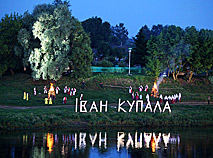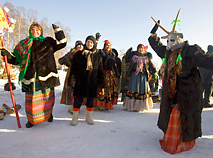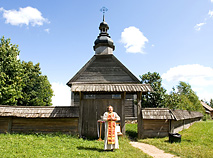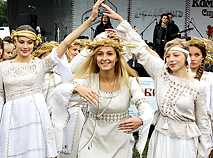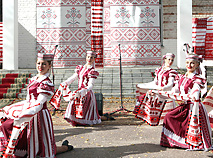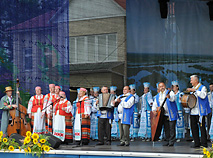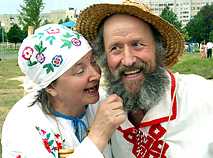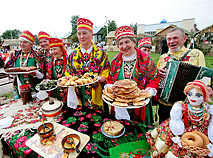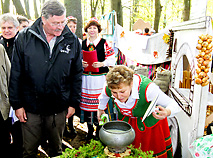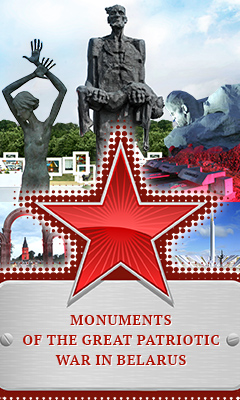Ethno-Tourism in Belarus

What did Belarus look like hundreds of years ago? What is so unique about its culture? What Belarusian traditions are famous around the world and how can our country amaze ethno-tourists?
 Belarusians are proud of their heritage and the unique culture they have carved out over many centuries of history. Traditional festivals and rites, folklore songs and dances, indigenous crafts, national costumes and cuisine – all this is intrinsically linked to national identity and can give a unique experience to tourists.
Belarusians are proud of their heritage and the unique culture they have carved out over many centuries of history. Traditional festivals and rites, folklore songs and dances, indigenous crafts, national costumes and cuisine – all this is intrinsically linked to national identity and can give a unique experience to tourists.
Ethnographic Museums, Complexes and Estates
There are a lot of places in Belarus that can give you a glimpse into traditional Belarusian culture and help you see how Belarus looked like many centuries ago. They are
-
Ethnographic and local lore museums
-
Open-air ethnographic complexes (villages)
-
Rural tourism estates
-
Centers for traditional crafts, vernacular architecture and ethnic heritage
-
Folk houses
-
Crafts houses
Visitors to these museums will be able to see household items, craftwork, hear authentic Belarusian songs watch traditional dances and get a taste of the national cuisine.
 Rural tourism estates will offer something uniquely Belarusian. They will give an opportunity to experience a rural life as it was many centuries ago. Here you will be able to visit a bee garden, a hayfield, have a stroll in the forest, attend master classes in bread baking, basket and broom weaving, ride a horse, go fishing and hunting, do archery, and many more.
Rural tourism estates will offer something uniquely Belarusian. They will give an opportunity to experience a rural life as it was many centuries ago. Here you will be able to visit a bee garden, a hayfield, have a stroll in the forest, attend master classes in bread baking, basket and broom weaving, ride a horse, go fishing and hunting, do archery, and many more.
Traditional Festivals and Rites
In Belarus traditional festivals are greatly cherished and draw crowds of people both in the city and the countryside.
The most famous of them include:
-
Koliada (Christmas rite)
-
Maslenitsa (Pancake Week)
-
Gukanne Vyasny (Calling of Spring)
-
Saint George’s Day
-
Kupalle
-
Zazhynki and Dazhynki harvest festivals
Open-air celebrations are held across the entire country during these festivals.
Some rites have survived only in individual communities. They are:
-
Christmas Tsars (this unique Belarusian rite that is performed only in the village of Semezhevo (Kopyl District) was inscribed on the UNESCO List of Intangible Cultural Heritage)
-
Pulling the Kolyada Up the Oak (the village of Noviny, Berezino District)
-
Tereshka’s Wedding (the village of Anoshki, Lepel District)
-
Children’s Christmas rite Kury (Klichev District)
-
Saint’s George’s Round Dance (the village of Pogost, Zhitkovichi District)
-
Strelka spring rite (the village of Bezdezh, Drogichin District)
 The harvest festival Dazhynki is one of the most significant holidays of modern-day Belarus. This festival is held every autumn to honor the best workers and celebrate the end of the autumn harvesting.
The harvest festival Dazhynki is one of the most significant holidays of modern-day Belarus. This festival is held every autumn to honor the best workers and celebrate the end of the autumn harvesting.
This remarkable festival features performances of folk singers and dancers, master classes in traditional crafts and an exhibition of handmade souvenirs.
Traditional Crafts
Traditional crafts reflect the profound character and history of Belarusian people. These crafts were passed on from generation to generation and have survived to this very day.
The most popular crafts include:
-
Blacksmithing
-
Pottery and ceramics
-
Weaving and embroidery
-
Straw and willow weaving
-
Carpentry and barrel making
-
Woodcarving and birch bark carving
-
Paper art
Craftwork is of great historical and cultural significance and is carefully preserved by museums.
It is not just as work of art where its significance lies. Some craftwork has become a cultural symbol of our nation. These are the famous Slutsk belts, rushnyks from the villages of Neglyubka and Semezhevo, aprons from Bezdezh, Dribin felt boots, amulet dolls from flax, straw spiders…
 For example, Neglyubka rushnyks made by weavers with the use of wooden "krosny" or looms are known all over the world. They have been awarded gold medals at international expos in New York, Montreal, Tokyo, Paris and Brussels. One of Belarus’ offices at the United Nations is decorated with rushnyks, and the Metropolitan Museum acquired them for its collection.
For example, Neglyubka rushnyks made by weavers with the use of wooden "krosny" or looms are known all over the world. They have been awarded gold medals at international expos in New York, Montreal, Tokyo, Paris and Brussels. One of Belarus’ offices at the United Nations is decorated with rushnyks, and the Metropolitan Museum acquired them for its collection.
In 2012 the village of Neglyubka (Vetka District) hosted the first festival of Belarusian rushnyks, which became an annual event.
The pride of the Belarusian culture are folk costumes with distinctive white-and-red colors, symbolic embroidery and, of course, particular traditions of wearing. Belarus has more than 30 varieties of folk costumes, which were common in various parts of the country.
 The Belarusian village of Bezdezh (Drogichin District) has the world’s only museum of aprons with a unique collection of clothing items that have become a true local brand.
The Belarusian village of Bezdezh (Drogichin District) has the world’s only museum of aprons with a unique collection of clothing items that have become a true local brand.
Today, almost every district of the country has arts and crafts centers which study the old techniques of arts and crafts, arrange exhibitions and workshops, make souvenirs.
Workshops of local artisans are held at all festivals and street fests across Belarus. The Town of Artisans at the International Arts Festival Slavonic Bazaar in Vitebsk has earned special love and popularity among people.
There are also exhibitions and fairs of craftsmen:
-
fair of arts and crafts "Mlyn" (Minsk)
-
fair of national arts and crafts "Komarovo – Circle of Days" (the village of Komarovo, Myadel District)
-
international ceramics plein-air "Art-Zhyzhal"
-
Belarusian Flax Fest
Festivals of National Culture and Cuisine
 At different times of the year the regions of Belarus hold interesting and in many ways unique festivals of national culture, which become increasingly popular with numerous guests and participants every year:
At different times of the year the regions of Belarus hold interesting and in many ways unique festivals of national culture, which become increasingly popular with numerous guests and participants every year:
-
Festival of ethnic and cultural traditions "Polesye Calling" (Pripyatsky National Park)
-
Kamyanitsa Folk Festival (Minsk District)
-
Humor comedy festival in Avtyuki (Kalinkovichi District, Gomel Oblast)
-
Rural tourism festival "Zaborsky Fest" (Rassony District, Vitebsk Oblast)
-
Folk art festival "Melodies of My Land" (Minsk Oblast)
-
International folk art festival "Friendship Wreath" (Bobruisk)
-
Nationwide festival of ethnic cultures in Grodno
-
National folk festival "Beraginya" (Oktyabrsky, Gomel Oblast)
-
Kupalle festival ("Alexandria Gathers Friends") (Shklov District, Mogilev Oblast)
 In addition, the towns and villages in Belarus that are famous for the ancient culinary traditions, and are home to successful enterprises of food industry, hold "delicious" fests.
In addition, the towns and villages in Belarus that are famous for the ancient culinary traditions, and are home to successful enterprises of food industry, hold "delicious" fests.
These are festivals of milk, potatoes, kvass, beer, cheese, chocolate, apples, cucumbers, cranberries, honey. Most popular recently are:
-
Food festival "Motalskiya Prysmaki" ("Motal Treats") (Ivanovo District)
- Environment festival "Cranes and Cranberries of Miory Land"
-
Day of Cucumbers in Shklov
-
Cherry Festival (the town of Glubokoye)
 Belarusian cuisine is rich in interesting traditions of cooking, unique dishes and drinks. You can try them at ethno-cultural and culinary festivals, ethnographic museums and rural estates.
Belarusian cuisine is rich in interesting traditions of cooking, unique dishes and drinks. You can try them at ethno-cultural and culinary festivals, ethnographic museums and rural estates.
For example, you can taste the unique dishes that are on the List of Intangible Cultural Heritage of Belarus ("buttery sheep", rye bread).
Major cultural-ethnographic centers and national parks serve unique home-distilled beverages such as:
-
Dudutki in Dudutki Museum
-
Korchma Hlebnaya in the Belarusian ethnographic village of the 19th century
-
Logoika in the Logoisk ski resort (Gastinny Maentak)
-
Pushchansky in Belovezhkaya Pushcha







 print version
print version make home page
make home page add to bookmarks
add to bookmarks